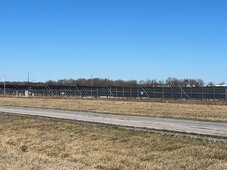KevinC_63559
New Member
While traveling towards St. Louis on Monday I noticed a solar field on the way. It was across the highway, so couldn't really stop, but per the car compass the panels were facing south-west (compass not particularly accurate). I looked in the rear view mirror and verified they were bifacial. Thought that facing was interesting.
Coming back to the farm we passed it again (obviously), but this time I was looking for it and snapped a few photos. The first exclamation from my wife was "They moved!". And indeed they did, they are apparently tracking panels. We past them the first time in the afternoon when they were facing south west, but this morning they were north east (both by the car compass and this time my phone compass).
If you look closely at the zoomed in photo, it appears the center is a round axis that presumably tilts as a unit.
Anyone know of anything similar for smaller home installed. These photographed units are presumable built to handle our state level winds, although my local situation is higher than the state average (high enough that we have some local wind farms).
Thinking I'll eventually have about 32 XXL panels for the house and 16 for the office project.
Particularly found it interesting that 1) They used bifacial panels and 2) they appear to have been faced to optimize afternoon sun collection. SW neither being neither the traditional south fixed tilt, nor east/west tracked.
Any thoughts? Guessing those mounts, with installation material, cost as much or more than the panels themselves.
Coming back to the farm we passed it again (obviously), but this time I was looking for it and snapped a few photos. The first exclamation from my wife was "They moved!". And indeed they did, they are apparently tracking panels. We past them the first time in the afternoon when they were facing south west, but this morning they were north east (both by the car compass and this time my phone compass).
If you look closely at the zoomed in photo, it appears the center is a round axis that presumably tilts as a unit.
Anyone know of anything similar for smaller home installed. These photographed units are presumable built to handle our state level winds, although my local situation is higher than the state average (high enough that we have some local wind farms).
Thinking I'll eventually have about 32 XXL panels for the house and 16 for the office project.
Particularly found it interesting that 1) They used bifacial panels and 2) they appear to have been faced to optimize afternoon sun collection. SW neither being neither the traditional south fixed tilt, nor east/west tracked.
Any thoughts? Guessing those mounts, with installation material, cost as much or more than the panels themselves.




